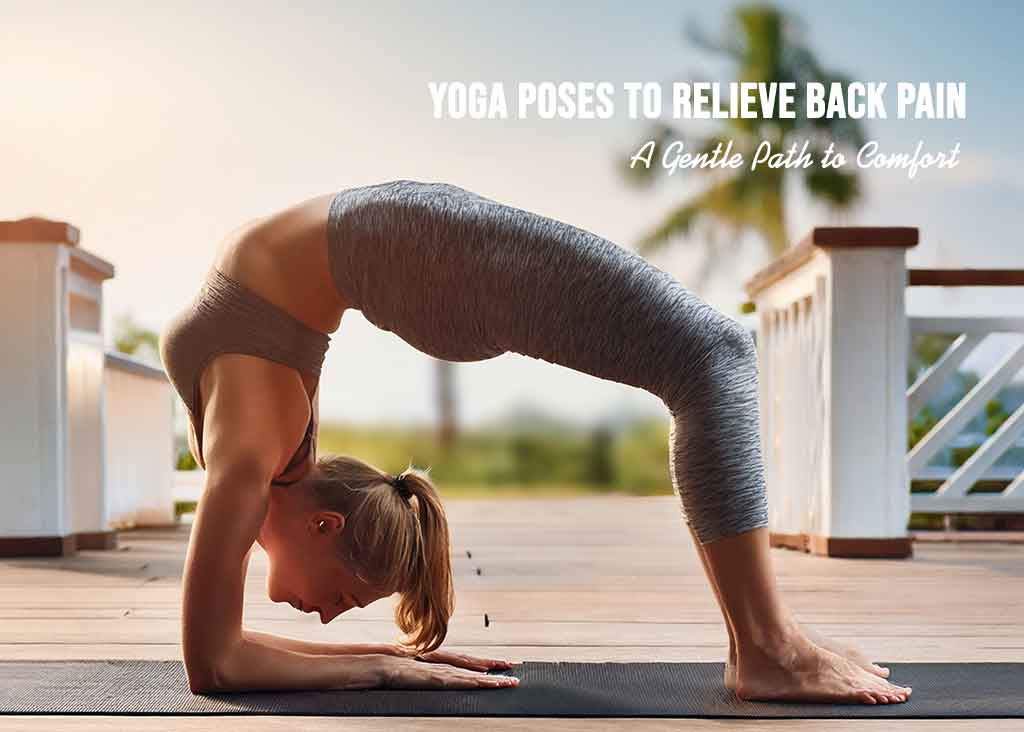Yoga Poses to Relieve Back Pain: A Gentle Path to Comfort

Back pain is a common issue that affects millions of people, often caused by poor posture, stress, muscle strain, or sedentary lifestyles. Yoga, with its focus on gentle stretching, strengthening, and mindfulness, offers an effective, natural way to alleviate back pain and improve spinal health. In this blog, we’ll explore five beginner-friendly yoga poses that target back pain, promote flexibility, and strengthen the muscles supporting your spine. Always consult a healthcare professional before starting any new exercise routine, especially if you have chronic or severe back pain.
Why Yoga for Back Pain?
Yoga combines physical movement, breath control, and relaxation to address both the symptoms and root causes of back pain. It helps by:

- Stretching tight muscles: Eases tension in the lower back, hips, and hamstrings.
- Strengthening core and back muscles: Supports the spine and improves posture.
- Reducing stress: Calms the nervous system, which can reduce pain perception.
- Increasing mobility: Enhances flexibility and range of motion in the spine.
- Stretching tight muscles: Eases tension in the lower back, hips, and hamstrings.
Here are five yoga poses that are particularly effective for relieving back pain. Hold each pose for 5–10 breaths (about 30 seconds to a minute) and move slowly to avoid strain.
1. Cat-Cow Pose (Marjaryasana-Bitilasana)
Benefits: Warms up the spine, improves flexibility, and releases tension in the back and neck.
How to do it:
- Start on all fours in a tabletop position, with your wrists under shoulders and knees under hips.
- Cow Pose: Inhale, drop your belly toward the mat, lift your chest and tailbone, and look forward.
- Cat Pose: Exhale, round your spine toward the ceiling, tuck your chin to your chest, and draw your belly in.
- Flow smoothly between Cat and Cow, syncing movement with your breath for 6–8 cycles.
Why it helps: This gentle flow mobilizes the spine, stretches the back muscles, and promotes circulation, easing stiffness and discomfort.
2. Child’s Pose (Balasana)
Benefits: Stretches the lower back, hips, and thighs while promoting relaxation.
How to do it:
- Kneel on the floor with your big toes touching and knees slightly wider than hip-width apart.
- Sit back on your heels, then slowly lower your chest toward the ground, extending your arms forward or resting them by your sides.
- Rest your forehead on the mat and breathe deeply, letting your back soften.
- For a variation, thread one arm under your body (Thread the Needle) to gently twist and stretch the upper back.
Why it helps: Child’s Pose gently stretches the lower back and decompresses the spine, relieving tension and calming the nervous system.
3. Downward-Facing Dog (Adho Mukha Svanasana)
Benefits: Stretches the hamstrings, calves, and back while strengthening the core and spine.
How to do it:
- ● From all fours, tuck your toes under and lift your hips toward the ceiling, forming an inverted “V” shape.
- ● Keep your knees slightly bent if your hamstrings are tight, and press your heels gently toward the floor.
- ● Spread your fingers wide, press into your palms, and lengthen your spine.
- ● Hold and breathe deeply, feeling a stretch through your back and legs.
Why it helps: Downward Dog elongates the spine and stretches tight hamstrings, which can contribute to lower back pain when inflexible.
4. Sphinx Pose (Salamba Bhujangasana)
Benefits: Strengthens the lower back and core while gently stretching the spine.
How to do it:
- Lie face down on the mat with your legs extended back and feet hip-width apart.
- Place your forearms on the ground, elbows under your shoulders, and press into your arms to lift your chest slightly.
- Keep your shoulders relaxed and gaze forward to avoid straining your neck.
- Engage your core and breathe deeply, feeling a gentle backbend.
Why it helps: Sphinx Pose strengthens the muscles along the spine and promotes a gentle backbend, counteracting the effects of slouching or sitting for long periods.
5. Supine Twist (Supta Matsyendrasana)
Benefits: Releases tension in the lower back and improves spinal mobility.
How to do it:
- Lie on your back with your legs extended.
- Hug your right knee to your chest, then guide it across your body to the left, keeping your right shoulder grounded.
- Extend your right arm out to the side and gaze toward it, or keep your head neutral.
- Hold for 5–10 breaths, then switch sides.
Why it helps: This gentle twist stretches the lower back, glutes, and obliques, relieving tightness and improving spinal flexibility.

Tips for Practicing Yoga Safely
You don’t need fancy gear or a studio. All you need is comfortable clothing and a safe, peaceful place to walk—even a city park or a quiet sidewalk can work.
- Start slowly: If you’re new to yoga or have back pain, begin with gentle poses and avoid overexertion.
- Use props: A yoga block or folded blanket can support your body in poses like Child’s Pose or Sphinx Pose.
- Listen to your body: Stop if you feel pain (beyond mild discomfort) and avoid forcing movements.
- Consult a professional: Work with a certified yoga instructor or physical therapist if you have chronic back issues.
Additional Tips for Back Pain Relief
- Practice regularly: Aim for 10–15 minutes of yoga daily or a few times a week for cumulative benefits.
- Combine with other habits: Pair yoga with proper posture, ergonomic adjustments, and regular movement to prevent pain.
- Stay mindful: Focus on your breath and move with intention to maximize relaxation and alignment.
Conclusion
Yoga offers a holistic approach to managing back pain by addressing physical tension, muscle imbalances, and stress. Poses like Cat-Cow, Child’s Pose, Downward Dog, Sphinx Pose, and Supine Twist are accessible and effective for most beginners. By practicing consistently and mindfully, you can reduce discomfort, improve mobility, and support long-term spinal health. For personalized guidance, consider consulting a yoga instructor or healthcare provider to tailor your practice to your needs.
Join our community today and take the first step towards a healthier, more balanced you.
Note: This is for informational purposes only and should not replace professional medical advice. Always consult a healthcare professional before starting any new treatment or session.
Photo: @Freepik, @unsplash @mircosoft designer

